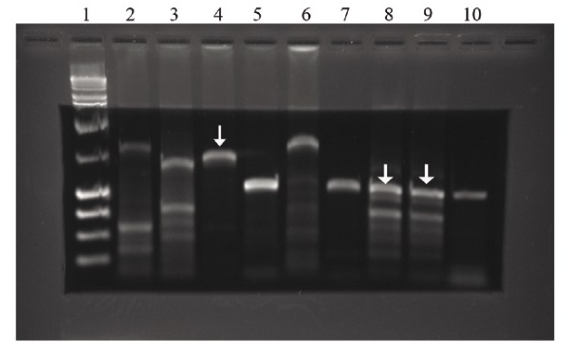PCR clean up - MetabolicEngineeringGroupCBMA/MetabolicEngineeringGroupCBMA.github.io GitHub Wiki
| Component | Volume |
|---|---|
| PCR mixture | 5 µL |
| Exonuclease I (Exo I) | 0.5 μL (10 U) |
| FastAP or Shrimp Alkaline Phosphatase (SAP) 1 μl (1 u) | 1 µL (1 U) |
- Mix well and incubate at 37°C for 15 min.
- Stop the reaction by heating the mixture at 85°C for 15 min.
Werle, E., C. Schneider, M. Renner, M. Völker, and W. Fiehn. 1994. “Convenient Single-Step, One Tube Purification of PCR Products for Direct Sequencing.” Nucleic Acids Research 22 (20) (October 11): 4354–4355.
Kim, J. B., and S. Blackshaw. 2001. “One-Step Enzymatic Purification of PCR Products for Direct Sequencing.” Current Protocols in Human Genetics / Editorial Board, Jonathan L. Haines... [et Al.] Chapter 11 (November): Unit 11.6.
Prepare an agarose gel.
Cut out a rectangle in the middle.
Pour 0.1% LMP agrose in the hole.
Separate the PCR product until it migrates into the LMP agarose.
Pipeting the PCR product from the LMP gel to an eppendorf tube.
Add primers and send away for sequencing.

Ma, Hao, and Stephen Difazio. 2008. “An Efficient Method for Purification of PCR Products for Sequencing.” BioTechniques 44 (7) (June): 921–923.
PCR clean up kit
Initial Step for achieving a pink-colored pellet: Add 6μl of pink co-precipitant to your nucleic acid sample and mix thoroughly for 30 seconds. For samples ≥ 200μl, increase the amount of pink co-precipitant accordingly, but never use more than 20μl. (Note: To ensure an efficient recovery, a minimum of 3μl of pink co- precipitate must be used)
-
Add an equal volume of SureClean to nucleic acid solution and mix thoroughly.
-
Incubate at room temperature for at least 10 mins.
-
Centrifuge at maximum speed (best results at 14,000x g) in a bench-top centrifuge for 10 minutes and carefully remove supernatant by aspiration. (Note: Centrifuging for longer time leads to better DNA recovery)
-
Add a volume of 70% Ethanol equal to 2x original sample volume and vortex for 10 seconds. (Note: For sensitive applications an optional second ethanol wash can be performed)
-
Centrifuge at maximum speed (best results at 14,000 x g) in a bench-top centrifuge for 10 minutes, remove supernatant and air- dry to ensure complete removal of ethanol. (Note: Do not overdry the pellet)
-
Resuspend pellet in desired volume of TE, water or any other appropriate buffer for downstream procedures.
Notes:
A. Apparent molecular weight of the DNA treated (agarose gel electrophoresis) may be higher if the washing-step with 70% ethanol step is omitted. For accurate MW assay, two washing steps are recommended after the cleaning procedure.
B. Nucleic acids to be purified must be ≥ 100 bp.
C. Easier visualisation of the pellet can be achieved with a pink co-precipitant which is supplied in the Bioline SureClean Plus (BIO-37047).
http://openwetware.org/wiki/Isopropanol_Precipitation_for_PCR_Purification